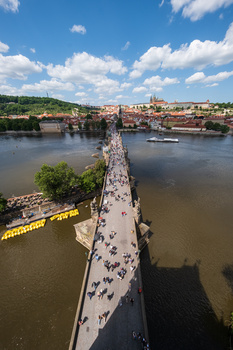The Fujifilm X-S20 is here, and it truly feels like a complete package for enthusiasts, hobbyists, vloggers, content creators, and a combination of all of the above. It's a small camera body packed with many professional features. So what’s the catch? Is there one?
Compact But in all The Good Ways
The body remains largely unchanged from the previous iteration of the X-S model. It still feels very small in the hand, however, with a very deep and ergonomically pleasing grip. Holding the camera feels safe and secure. Even though some might object to the fact the camera is so small your pinky is not even touching the body, I did not mind it at all. My grip remained firm, and not once have I felt like I could have dropped the camera.
The layout of all the controls has remained identical to the X-S10. Only a few of the buttons on the top of the body have been enlarged and shifted a bit. If it works, don’t fix it. We still have the “DSLR-like” digital way of controlling the exposure instead of the analog-style dials we are used to from Fujifilm. So, the three programmable dials are still here with the same functionality. It is a bit amusing that the “lower-end” X-S20 has more dials to control your exposure than professional bodies like X-H2 or the X-H2S. Both of those only have the rear and the front dial, so one of those has to be swapped in between modes like exposure compensation and ISO, whereas the X-S20 has a third dial on the opposite side, which you can permanently set to ISO. It makes so much sense once you use it.

Improved Connectivity
The ports have stayed mostly the same apart from a few major changes. We still get a USB-C for charging and power delivery, however, the speed has been doubled from 5 Gbps to 10 Gbps. It is also webcam-enabled out of the box. The mic input sits nicely above the ports, so as not to cover the screen when flipped forward. The micro-HDMI brings a large update, but more on that in the video section. The best upgrade to the ports is the inclusion of the 3.5 mm headphone jack for instant audio monitoring. It sits on the opposite side of the body for more comfortable use. The SD card slot is still next to the battery; however, it is now UHS-II compatible. This is most definitely needed for the video specs.
More of the Same? Not Really
Many were wondering what the new sensor is going to be. Some thought it would be the 40-megapixel one from X-T5, and some hoped for the stacked one from X-H2S. Luckily, we got something slightly different. The same BSI X-Trans 4 from the previous generation of Fujifilm cameras is running the show, just like it was in the X-S10 or any other previous generation camera. I see that as a good thing. The sensor has always delivered whenever I needed it when I used my X-Pro3, X-T4, or my current backup body, the X-T3. The image quality, low-light performance, and speed were more than enough for most uses, but this time the sensor is backed up by the new generation processor, the X-Processor 5.

What does that mean? We can enjoy all the benefits of the new processor at a lower cost of a cheaper sensor. The most notable improvement is in the autofocus department. The subject detection, tracking, AF acquisition, and buffer have all improved considerably. We get a whole lot more subjects to track. I’ve tried many different ones, and the only time I’ve gotten any missed shots were when the motors in my slower lenses just could not keep up with the movement of the subject. But whenever I used faster-moving glass, the experience was brilliant.
The same goes for the buffer. The X-S10 was capable of shooting 17 raw files in 20 fps mode or 21 raw files in 10 fps mode. The new processor is capable of either 79 raws at 20 fps or 341 raws at 10 fps. The improvement is massive. Last but not least, we also get a new film simulation Nostalgic Negative, which is great for warmer portraits. This one has been introduced a while back but never before on an X-Trans 4 camera.
The Most Significant Improvement: Video
The X-S line-up was always marketed towards video makers. The X-S20 is going all out in terms of video, better than the more premium X-T5 in some regards. The processor is seriously showing us what the sensor can do. This tiny body can do DCI 4K video at 60 fps. It can record internally at 10-bit 4:2:2 and 360 Mbps as well as 6.2K 30 fps open gate using the entire sensor. We also get F-Log2 on top of the already present F-Log, so now, the dynamic range reaches above 13 stops. The aforementioned micro-HDMI can even output 12-bit raw video.
Overheating is definitely an issue in such a small body, but thankfully, Fujifilm has thought of that beforehand and made the back of the body compatible with the FAN-001 accessory introduced with the release of the X-H2S. 1080p video can now also be recorded up to 240 fps but saved at 24 fps for 10x slow motion straight out of the camera.
Vloggers will also welcome the dedicated Vlog mode on the dial, allowing them to change various settings using just the articulating touchscreen.

What I Liked
I loved the compact size while being ergonomically well-thought-out, making the camera perfectly balanced. It feels great in the hand and takes up very little space in the bag. Sure, the viewfinder is lower resolution than most cameras today, but the image is still clear and easily viewable. The battery life is so good I never needed to pay any attention to it. The shutter mechanism is one of the cheaper units Fujifilm makes, capable of only 1/4,000 s in mechanical mode, but the camera seamlessly switches to the electronic one when needed to go up to 1/32,000 s.
The control scheme, including the customizable dials, made exposure control simple and easy. In fact, the entire experience was fast, simple, and easy. I’d definitely consider the camera to be my daily street photography shooter thanks to its speed and size. And the cherry on top is the new AF system. It was just great!
What I Didn’t Like
I do understand the reasoning behind it, but weather-sealing would be a nice addition. My best guess is the fact it would make the camera either more expensive or larger. Maybe both. So yeah, keep it this way. The single card slot did not help with my fear of losing files. I’ve had cards fail on me before, so built-in storage would be pretty cool if there’s no more room for a second slot. Some cameras have already shown it is possible.
As mentioned before, the shutter mechanism is the lower-end one compared to the pro-level bodies, so the sound it makes does not sound as pleasing as the X-H2(S) or the X-T5, but that’s just me nit-picking.

Samples
An Almost Complete Package
As I’ve said before, the Fujifilm X-S20 is a mighty camera in a tiny body. Paired with the right lens, it can be perfect for a street photographer, traveling shooter, enthusiast, hobbyist, or even a fun camera for a pro to use on their days off. I know I would not mind having one, even though I am more than happy with my X-T5.
YouTubers, video makers, amateur filmmakers, and cinema students might just love this one. The video features are incredible considering the size and price. The image quality, the bitrates, the recording options, the active cooling option, the battery life, and the seven stops of image stabilization make the X-S20 a very strong contender over the likes of Nikon Z30, Sony ZV-E10, Canon R10, or any other “vlogger-centric” camera.



























Elephant in the room: those hoping for a more affordable camera that embodies the essence of Fuji with the retro styling and tactile dials are not going to find it here. And it is these features and design language that have sparked somewhat of a Fuji renaissance.
So, it seems an odd decision that this camera be the one that is launched right now. Just like at the top end, classic Fuji camera releases are getting second billing to those that look and feel like Sony and Canon. A shame considering for example the x-t5 is the one that will top the sales figures, yet it is "downgraded" in some areas to enable the x-h2 to shine brighter...rather than simply allowing the x-h2 to shine brighter on merit alone.
And so too, here. Where's the X-t40 or x-pro4? The X-s10 was released after both and yet is the first to be updated. As great as the x-s20 seems to be, you have to wonder about Fuji's priorities. And with nothing on the x-mount roadmap while third parties run riot - what is Fuji doing to appeal to the enthusiastic user base and new users struggling to find their desired retro models in stock anywhere (x-e4, x100v)?
Good point.
It is an odd choice out of their lineup. I'm hoping that we're still getting X-T40 or X-E5 sometime this year. X-Pro4 would be great but there are no cheap options at all at the moment.
What is the Color Film Simulation that you use on these samples? Is it Astia? Have you fine tuned the original formular? This was a very good insight into this new camera.
It is a mixture of Astia, Provia, Pro Neg, Classic Chrome, Classic Negative as well as Adobe Landscape profile in Lightroom. Some tweaks were done in Lightroom to highlights, shadows, and maybe a bit of curves but no sharpening or denoising was done.
Thank you very much!